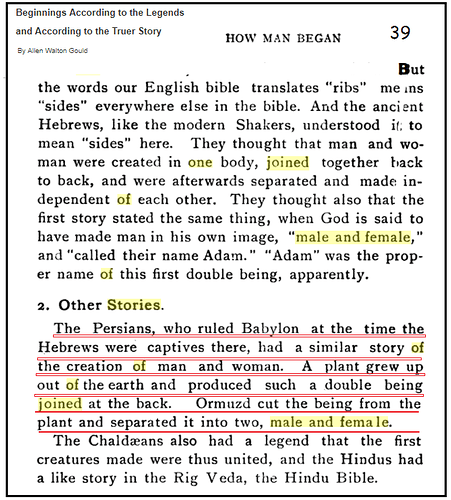That’s a solid treatment right there… and then of course there is the fascinating suggestion that yet another editor of the story tried to make the same words carry TWICE the load!: while one perspective carried the “side of a body” meaning… there was another level of meaning that I think is plausible … but not necessarily mandatory.
I’m sure you’ve read it before … the idea that the story was explaining something that any animal handler may have wondered over and over … how is it that of all the mammals in the world, why are human males born with ONE LESS BONE?
It would not be surprising if someone was trying to imply why there was a “side” (aka, appended) bone put to good use somewhere else!
What is sometimes not well appreciated is where this idea of JOINED-GENDER human origins first came from! - - and it wasn’t from the Semites.
In Plato’s work, the Symposium, there is a scene where stories are told in an air of competition … to tell the most beautiful … or at least the most amazing… of stories. And Plato tells the story of Aristophanes telling the story of the origins of human love!
Aristophanes says that at the beginning of the world human beings looked very different:
“Primeval man was round, his back and sides forming a circle; and he had four hands and four feet, one head with two faces, looking opposite ways, set on a round neck and precisely alike… He could walk upright as men now do, backwards or forwards as he pleased, and he could also roll over and over at a great pace, turning on his four hands and four feet, eight in all, like tumblers going over and over with their legs in the air; this was when he wanted to run fast.”
These weird, fused humans had three sexes, not the two we have today. Some were male in both halves, some were female in both haves, and others had one male half and another female half. According to this tale, they were more powerful than today’s frail human creatures. Aristophanes says, “Terrible was their might and strength, and the thoughts of their hearts were great, and they made an attack upon the gods.”
The gods met to discuss how they would deal with these circular attackers. Several suggested all-out slaughter. But Zeus said that humanity simply needed to be humbled, not destroyed. The gods decided to sever the humans in two. “And if they continue to be insolent and will not be quiet,” said Zeus, “I will split them again and they shall hop about on a single leg.”
The gods halved the humans. And so now, in this new age of split selves, the two halves roam the face of the earth searching for one another. Male searching for male, female searching for female, and male and female searching for each other – it is all part of the same story, according to the playwright. And finding that other, original part of yourself… That is love. As Aristophanes concludes,
“After the division the two parts of man, each desiring his other half, came together, and throwing their arms about one another, entwined in mutual embraces, longing to grow into one.”
To answer the question implied already… where did this story first come from? It comes from the origin myths of the Persians (who may have received them from the Hindu, or from a common source for both) … which Plato apparently thought was at least plausible.
[ Click on the image to enlarge for better viewing. ]
